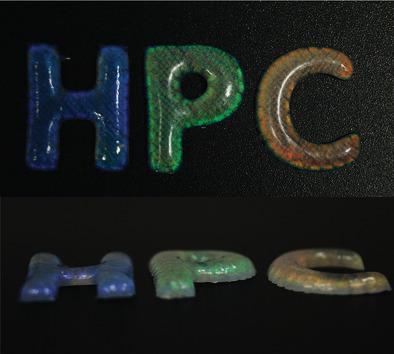当前位置:
X-MOL 学术
›
Adv. Funct. Mater.
›
论文详情
Our official English website, www.x-mol.net, welcomes your feedback! (Note: you will need to create a separate account there.)
3D Printing of Liquid Crystalline Hydroxypropyl Cellulose—toward Tunable and Sustainable Volumetric Photonic Structures
Advanced Functional Materials ( IF 19.0 ) Pub Date : 2022-01-13 , DOI: 10.1002/adfm.202108566 Chun Lam Clement Chan 1 , Iek Man Lei 2 , Gea T. van de Kerkhof 1 , Richard M. Parker 1 , Kieran D. Richards 3 , Rachel C. Evans 3 , Yan Yan Shery Huang 2 , Silvia Vignolini 1
Advanced Functional Materials ( IF 19.0 ) Pub Date : 2022-01-13 , DOI: 10.1002/adfm.202108566 Chun Lam Clement Chan 1 , Iek Man Lei 2 , Gea T. van de Kerkhof 1 , Richard M. Parker 1 , Kieran D. Richards 3 , Rachel C. Evans 3 , Yan Yan Shery Huang 2 , Silvia Vignolini 1
Affiliation

|
Additive manufacturing is becoming increasingly important as a flexible technique for a wide range of products, with applications in the transportation, health, and food sectors. However, to develop additional functionality it is important to simultaneously control structuring across multiple length scales. In 3D printing, this can be achieved by employing inks with intrinsic hierarchical order. Liquid crystalline systems represent such a class of self-organizing materials; however, to date they are only used to create filaments with nematic alignment along the extrusion direction. In this study, cholesteric hydroxypropyl cellulose (HPC) is combined with in situ photo-crosslinking to produce filaments with an internal helicoidal nanoarchitecture, enabling the direct ink writing of solid, volumetric objects with structural color. The iridescent color can be tuned across the visible spectrum by exploiting either the lyotropic or thermotropic behavior of HPC during the crosslinking step, allowing objects with different colors to be printed from the same feedstock. Furthermore, by examining the microstructure after extrusion, the role of shear within the nozzle is revealed and a mechanism proposed based on rheological measurements simulating the nozzle extrusion. Finally, by using only a sustainable biopolymer and water, a pathway toward environmentally friendly 3D printing is revealed.
中文翻译:

液晶羟丙基纤维素的 3D 打印——迈向可调谐和可持续的体积光子结构
作为一种灵活的技术,增材制造正变得越来越重要,适用于运输、健康和食品领域的各种产品。但是,要开发附加功能,重要的是同时控制跨多个长度尺度的结构。在 3D 打印中,这可以通过使用具有内在层次顺序的墨水来实现。液晶系统代表了这样一类自组织材料;然而,迄今为止,它们仅用于制造沿挤出方向具有向列排列的细丝。在这项研究中,胆甾型羟丙基纤维素 (HPC) 与原位光交联相结合,生产出具有内部螺旋状纳米结构的细丝,从而能够直接用墨水书写具有结构颜色的固体、体积物体。通过在交联步骤中利用 HPC 的易溶或热致行为,可以在整个可见光谱范围内调整虹彩颜色,从而允许从相同的原料打印具有不同颜色的物体。此外,通过检查挤出后的微观结构,揭示了喷嘴内剪切的作用,并提出了一种基于模拟喷嘴挤出的流变测量的机制。最后,通过仅使用可持续的生物聚合物和水,揭示了通往环保 3D 打印的途径。揭示了喷嘴内剪切的作用,并提出了一种基于模拟喷嘴挤出的流变测量的机制。最后,通过仅使用可持续的生物聚合物和水,揭示了通往环保 3D 打印的途径。揭示了喷嘴内剪切的作用,并提出了一种基于模拟喷嘴挤出的流变测量的机制。最后,通过仅使用可持续的生物聚合物和水,揭示了通往环保 3D 打印的途径。
更新日期:2022-01-13
中文翻译:

液晶羟丙基纤维素的 3D 打印——迈向可调谐和可持续的体积光子结构
作为一种灵活的技术,增材制造正变得越来越重要,适用于运输、健康和食品领域的各种产品。但是,要开发附加功能,重要的是同时控制跨多个长度尺度的结构。在 3D 打印中,这可以通过使用具有内在层次顺序的墨水来实现。液晶系统代表了这样一类自组织材料;然而,迄今为止,它们仅用于制造沿挤出方向具有向列排列的细丝。在这项研究中,胆甾型羟丙基纤维素 (HPC) 与原位光交联相结合,生产出具有内部螺旋状纳米结构的细丝,从而能够直接用墨水书写具有结构颜色的固体、体积物体。通过在交联步骤中利用 HPC 的易溶或热致行为,可以在整个可见光谱范围内调整虹彩颜色,从而允许从相同的原料打印具有不同颜色的物体。此外,通过检查挤出后的微观结构,揭示了喷嘴内剪切的作用,并提出了一种基于模拟喷嘴挤出的流变测量的机制。最后,通过仅使用可持续的生物聚合物和水,揭示了通往环保 3D 打印的途径。揭示了喷嘴内剪切的作用,并提出了一种基于模拟喷嘴挤出的流变测量的机制。最后,通过仅使用可持续的生物聚合物和水,揭示了通往环保 3D 打印的途径。揭示了喷嘴内剪切的作用,并提出了一种基于模拟喷嘴挤出的流变测量的机制。最后,通过仅使用可持续的生物聚合物和水,揭示了通往环保 3D 打印的途径。



























 京公网安备 11010802027423号
京公网安备 11010802027423号